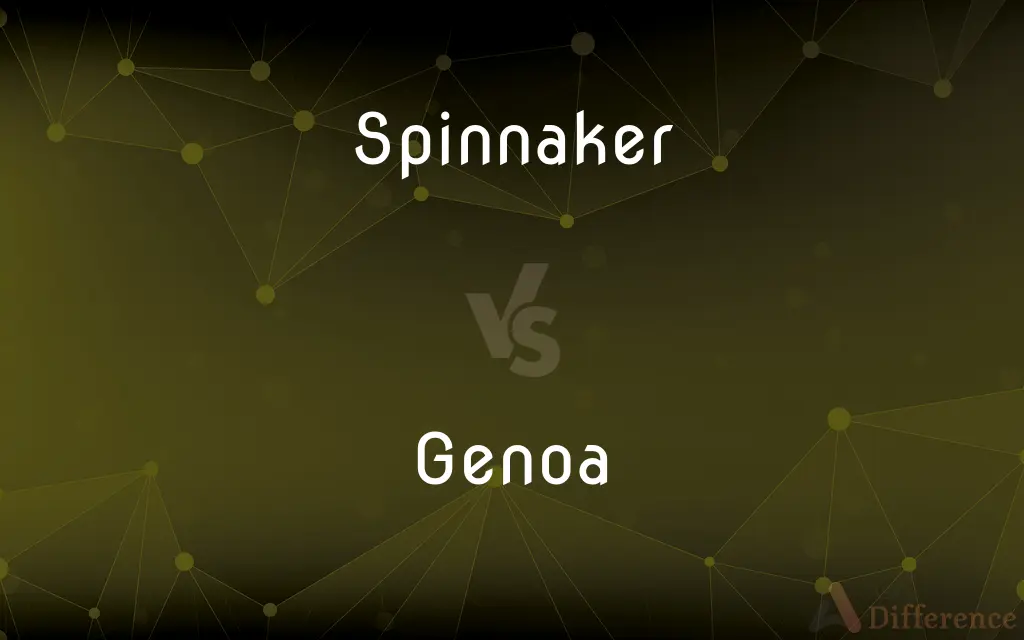Spinnaker vs. Genoa — What's the Difference?
By Fiza Rafique & Maham Liaqat — Updated on May 13, 2024
A spinnaker is a large, balloon-shaped sail used in sailing to catch downwind breezes, while a genoa is a type of jib that extends past the mast and is primarily used for upwind sailing.

Difference Between Spinnaker and Genoa
Table of Contents
ADVERTISEMENT
Key Differences
Spinnaker sails are typically used for sailing with the wind directly behind the boat (downwind). They are full and balloon-like, maximizing the area exposed to the wind for greater propulsion. Genoa sails, in contrast, are used for upwind sailing, extending beyond the mast to increase the sail area that catches the wind from the side (crosswinds).
Spinnakers are made from lightweight fabric due to their large size and the need for flexibility to billow out and capture the wind efficiently. Genoas are generally made from heavier fabric as they need to withstand higher wind pressures when the boat sails upwind.
Spinnakers require careful handling and are often deployed only in specific racing or cruising conditions due to their size and the skill needed to manage them effectively. Genoas, while also requiring skill, are more commonly used as part of regular sailing operations.
Spinnakers have different types based on the specific downwind course and wind conditions, such as the symmetrical and asymmetrical spinnakers. Genoas are categorized by their size, which is typically referred to by a number indicating their overlap with the mainsail.
Spinnakers offer a dramatic increase in speed in downwind conditions but can be unstable and challenging to control. Genoas, while enhancing speed and handling in upwind conditions, provide more stability but require correct trimming to maximize their effectiveness.
ADVERTISEMENT
Comparison Chart
Primary Use
Sailing downwind
Sailing upwind
Shape
Large, balloon-like
Oversized jib that overlaps the mast
Fabric Type
Lightweight, flexible
Heavier, more durable
Handling
Requires careful handling; used in specific conditions
Regular use in upwind conditions; requires skillful trimming
Types
Symmetrical, asymmetrical
Numbered based on size and overlap
Stability
Can be unstable and challenging to control
More stable, but needs proper trimming
Compare with Definitions
Spinnaker
Used in racing for its speed advantages in downwind conditions.
The race team prepared the spinnaker for the final downwind leg.
Genoa
A large jib sail that overlaps the mast, enhancing upwind performance.
They rolled out the genoa to tackle the upcoming upwind course.
Spinnaker
Can be symmetrical or asymmetrical depending on the sailing angle relative to the wind.
For the broad reach, they used an asymmetrical spinnaker.
Genoa
Categorized by size, with larger numbers indicating more overlap.
They switched to a Genoa 1 for less overlap in lighter winds.
Spinnaker
A sail designed for optimal speed downwind, billowing out in front of the boat.
They set the spinnaker as they turned downwind to maximize their speed.
Genoa
More durable due to its heavier fabric and exposure to higher wind pressures.
The new genoa was made from a heavier material to withstand strong winds.
Spinnaker
Known for its distinct shape and colorful appearance.
The regatta was vibrant with all the brightly colored spinnakers flying.
Genoa
Integral for cruising and racing, providing essential power upwind.
The genoa played a crucial role in their upwind strategy during the race.
Spinnaker
Requires additional gear and crew for deployment.
Deploying the spinnaker involved the whole crew coordinating.
Genoa
Requires precise trimming for optimal performance.
Proper trimming of the genoa improved their speed and heading.
Spinnaker
A spinnaker is a sail designed specifically for sailing off the wind from a reaching course to a downwind, i.e. with the wind 90–180° off bow.
Genoa
Genoa ( JEN-oh-ə; Italian: Genova [ˈdʒɛːnova] (listen); Ligurian: Zêna [ˈzeːna]; English, historically, and Latin: Genua) is the capital of the Italian region of Liguria and the sixth-largest city in Italy. In 2015, 594,733 people lived within the city's administrative limits.
Spinnaker
A large triangular headsail secured only at the corners, used on sailboats when running before the wind.
Genoa
(Nautical) A jib whose leech extends aft of the mast. Also called genoa jib.
Spinnaker
(nautical) A sail supplemental to the mainsail, especially a triangular one, used on yachts for running before the wind.
Genoa
(nautical) A staysail that resembles a jib but extends aft beyond the mast.
Spinnaker
(nautical) To sail using a spinnaker
Genoa
A seaport in northwestern Italy; provincial capital of Liguria
Spinnaker
A large triangular sail set upon a boom, - used when running before the wind.
Spinnaker
Large and usually triangular headsail; carried by a yacht as a headsail when running before the wind
Common Curiosities
Can a spinnaker be used for upwind sailing?
No, spinnakers are specifically designed for downwind sailing.
What are the main challenges of handling a spinnaker?
Challenges include managing its large size, preventing it from collapsing, and controlling it in changing winds.
What maintenance does a genoa require?
Regular inspections for wear and tear, proper cleaning, and storage to prevent damage from UV and moisture.
Can spinnakers be used in heavy winds?
They are generally not recommended for heavy winds due to control difficulties and the risk of damage.
Why might a sailor choose a genoa over a standard jib?
A genoa provides more sail area, which is beneficial for speed and efficiency, especially in light to moderate wind conditions upwind.
What conditions are best for using a spinnaker?
Best used in lighter winds and downwind sailing conditions.
Is it difficult to switch from a genoa to a spinnaker during sailing?
Yes, it requires careful coordination and timing, often involving multiple crew members to handle the sails safely.
How do you choose the right size genoa for different conditions?
The size choice depends on wind strength; larger genoas in lighter winds and smaller ones in stronger winds.
How does the asymmetrical spinnaker differ from the symmetrical one?
The asymmetrical spinnaker is designed for sailing at angles closer to the wind, while the symmetrical is best for directly downwind courses.
How does sail choice affect racing performance?
Choosing the right sail for the conditions can significantly affect speed, control, and overall race performance.
Share Your Discovery

Previous Comparison
Integrity vs. Sincerity
Next Comparison
Posh vs. SnobAuthor Spotlight
Written by
Fiza RafiqueFiza Rafique is a skilled content writer at AskDifference.com, where she meticulously refines and enhances written pieces. Drawing from her vast editorial expertise, Fiza ensures clarity, accuracy, and precision in every article. Passionate about language, she continually seeks to elevate the quality of content for readers worldwide.
Co-written by
Maham Liaqat












































